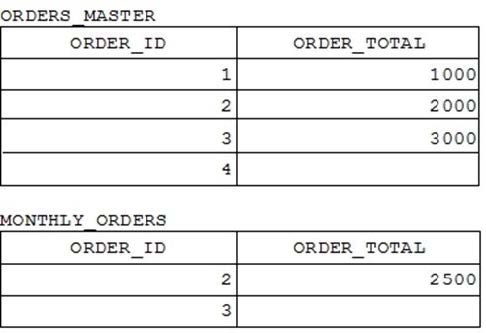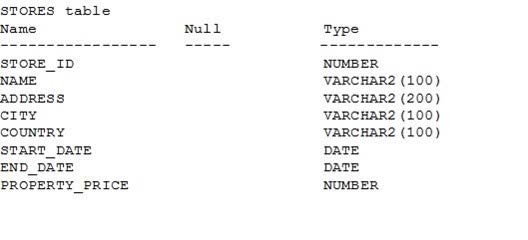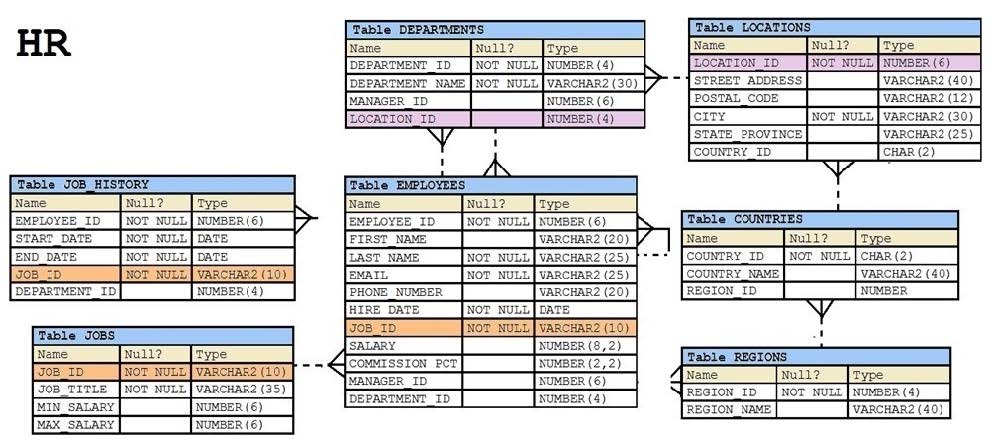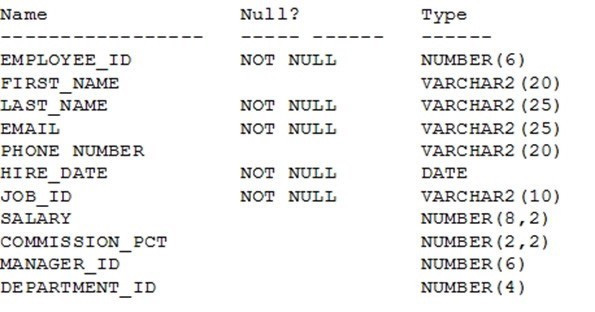Exam Details
Exam Code
:1Z0-071Exam Name
:Oracle Database SQLCertification
:Oracle CertificationsVendor
:OracleTotal Questions
:415 Q&AsLast Updated
:Jun 28, 2025
Oracle Oracle Certifications 1Z0-071 Questions & Answers
-
Question 71:
In Which three situations does a transaction complete?
A. when a PL/SQL anonymous block is executed
B. when a DELETE statement is executed
C. when a ROLLBACK command is executed
D. when a data definition language (DDL) statement is executed
E. when a TRUNCATE statement is executed after the pending transaction
-
Question 72:
View the exhibit and examine the data in ORDERS_MASTER and MONTHLY_ORDERS tables.

Evaluate the following MERGE statement:
MERGE_INTO orders_master o USING monthly_orders m ON (o.order_id = m.order_id) WHEN MATCHED THEN UPDATE SET o.order_total = m.order_total DELETE WHERE (m.order_total IS NULL) WHEN NOT MATCHED THEN INSERT VALUES (m.order_id, m.order_total)
What would be the outcome of the above statement?
A. The ORDERS_MASTER table would contain the ORDER_IDs 1, 2, 3 and 4.
B. The ORDERS_MASTER table would contain the ORDER_IDs 1, 2 and 4.
C. The ORDERS_MASTER table would contain the ORDER_IDs 1, 2 and 3.
D. The ORDERS_MASTER table would contain the ORDER_IDs 1 and 2.
-
Question 73:
Evaluate the following SQL statement:
SELECT product_name || 'it's not available for order'
FROM product_information
WHERE product_status = 'obsolete';
You received the following error while executing the above query:
ERROR
ORA-01756: quoted string not properly terminated
What would you do to execute the query successfully?
A. Remove the single quotation marks enclosing the character literal string in the SELECT clause
B. Use the escape character to negate the single quotation mark within the literal character string in the SELECT clause
C. Enclose the character literal string in the SELECT clause within double quotation marks
D. Use the Oracle (q) operator and delimiter to allow the use of a single quotation mark within the literal character string in the SELECT clause
-
Question 74:
View the exhibit and examine the structure of the STORES table.

You must display the NAME of stores along with the ADDRESS, START_DATE, PROPERTY_PRICE, and the projected property price, Which is 115% of property price.
The stores displayed must have START_DATE in the range of 36 months starting from 01-Jan-2000 and above.
Which SQL statement would get the desired output?
A. SELECT name, concat (address| | ','| |city| |', ', country) AS full_address, start_date, property_price, property_price*115/100 FROM stores WHERE MONTHS_BETWEEN (start_date, '01-JAN-2000') <=36;
B. SELECT name, concat (address| | ','| |city| |', ', country) AS full_address, start_date, property_price, property_price*115/100 FROM stores WHERE TO_NUMBER(start_date-TO_DATE('01-JAN-2000','DD-MON-RRRR')) <=36;
C. SELECT name, address||', '||city||', '||country AS full_address, start_date, property_price, property_price*115/100 FROM stores WHERE MONTHS_BETWEEN(start_date,TO_DATE('01-JAN-2000','DD-MON-RRRR')) <=36;
D. SELECT name, concat (address||','| |city| |', ', country) AS full_address, start_date, property_price, property_price*115/100 FROM stores WHERE MONTHS_BETWEEN (start_date, TO_DATE('01-JAN-2000','DD-MON-RRRR')) <=36;
-
Question 75:
The BOOKS_TRANSACTIONS table exists in your database.
SQL>SELECT * FROM books_transactions ORDER BY 3; What is the outcome on execution?
A. The execution fails unless the numeral 3 in the ORDER BY clause is replaced by a column name.
B. Rows are displayed in the order that they are stored in the table only for the three rows with the lowest values in the key column.
C. Rows are displayed in the order that they are stored in the table only for the first three rows.
D. Rows are displayed sorted in ascending order of the values in the third column in the table.
-
Question 76:
Examine the command:

What does ON DELETE CASCADE imply?
A. When the BOOKS table is dropped, the BOOK_TRANSACTIONS table is dropped.
B. When the BOOKS table is dropped, all the rows in the BOOK_TRANSACTIONS table are deleted but the table structure is retained.
C. When a row in the BOOKS table is deleted, the rows in the BOOK_TRANSACTIONS table whose BOOK_ID matches that of the deleted row in the BOOKS table are also deleted.
D. When a value in the BOOKS.BOOK_ID column is deleted, the corresponding value is updated in the BOOKS_TRANSACTIONS.BOOK_ID column.
-
Question 77:
View the exhibit and examine the structure of the EMPLOYEES table.

You want to display all employees and their managers having 100 as the MANAGER_ID. You want the output in two columns: the first column would have the LAST_NAME of the managers and the second column would have LAST_NAME of the employees.
Which SQL statement would you execute?
A. SELECT m.last_name "Manager", e.last_name "Employee" FROM employees m JOIN employees e ON m.employee_id = e.manager_id WHERE m.manager_id = 100;
B. SELECT m.last_name "Manager", e.last_name "Employee" FROM employees m JOIN employees e ON m.employee_id = e.manager_id WHERE e.manager_id = 100;
C. SELECT m.last_name "Manager", e.last_name "Employee" FROM employees m JOIN employees e ON e.employee_id = m.manager_id WHERE m.manager_id = 100;
D. SELECT m.last_name "Manager", e.last_name "Employee" FROM employees m JOIN employees e WHERE m.employee_id = e.manager_id AND e.manager_id = 100
-
Question 78:
Which three statements are true about multiple-row subqueries?
A. They can contain a subquery within a subquery.
B. They can return multiple columns as well as rows.
C. They cannot contain a subquery within a subquery.
D. They can return only one column but multiple rows.
E. They can contain group functions and GROUP BY and HAVING clauses.
F. They can contain group functions and the GROUP BY clause, but not the HAVING clause.
-
Question 79:
Examine the structure of the EMPLOYEES table.

There is a parent/child relationship between EMPLOYEE_ID and MANAGER_ID.
You want to display the last names and manager IDs of employees who work for the same manager as the employee whose EMPLOYEE_ID is 123.
Which query provides the correct output?
A. SELECT e.last_name, m.manager_id FROM employees e RIGHT OUTER JOIN employees m on (e.manager_id = m.employee_id) AND e.employee_id = 123;
B. SELECT e.last_name, m.manager_id FROM employees e LEFT OUTER JOIN employees m on (e.employee_id = m.manager_id) WHERE e.employee_id = 123;
C. SELECT e.last_name, e.manager_id FROM employees e RIGHT OUTER JOIN employees m on (e.employee_id = m.employee_id) WHERE e.employee_id = 123;
D. SELECT m.last_name, e.manager_id FROM employees e LEFT OUTER JOIN employees m on (e.manager_id = m.manager_id) WHERE e.employee_id = 123;
-
Question 80:
Which normal form is a table in if it has no multi-valued attributes and no partial dependencies?
A. second normal form
B. first normal form
C. third normal form
D. fourth normal form
Related Exams:
1Z0-020
Oracle8i: New Features for Administrators1Z0-023
Architecture and Administration1Z0-024
Performance Tuning1Z0-025
Backup and Recovery1Z0-026
Network Administration1Z0-034
Upgrade Oracle9i/10g OCA to Oracle Database OCP1Z0-036
Managing Oracle9i on Linux1Z0-041
Oracle Database 10g: DBA Assessment1Z0-052
Oracle Database 11g: Administration Workshop I1Z0-053
Oracle Database 11g: Administration II
Tips on How to Prepare for the Exams
Nowadays, the certification exams become more and more important and required by more and more enterprises when applying for a job. But how to prepare for the exam effectively? How to prepare for the exam in a short time with less efforts? How to get a ideal result and how to find the most reliable resources? Here on Vcedump.com, you will find all the answers. Vcedump.com provide not only Oracle exam questions, answers and explanations but also complete assistance on your exam preparation and certification application. If you are confused on your 1Z0-071 exam preparations and Oracle certification application, do not hesitate to visit our Vcedump.com to find your solutions here.